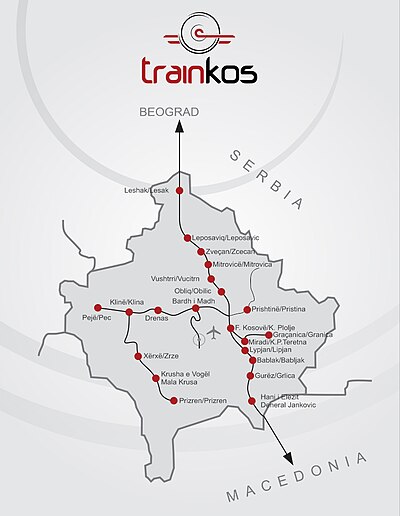User:ShkelzenKR/History of Kosovo Railways
 | |
| Overview | |
|---|---|
| Headquarters | Fushë Kosovë, Kosovo |
| Locale | Kosovo |
| Dates of operation | 1874–present |
| Technical | |
| Length | 333.951 kilometres (208 mi)Cite error: The <ref> tag has too many names (see the help page). |
| Other | |
| Website | www |
Kosovo Railways[edit]
The Railways of Kosovo in station territories take place from 333, 951 km up to 105,784 km, whereas the industrial lines involve 103,4 km. The Railways of Kosovo are a property of the public sector where the state has access to ruling all administrative actions in the Ministry of Economic Development.
Trains[edit]
Railway transports, most importantly, are one of the safest transports in Kosovo. Infrastructures and motor vehicles are technically safer compared to other transports. Nevertheless, they are immune to tough weather conditions such as snow, rain, fog, and so forth. Additionally, railway transports are ecological as well since they are provided with fuel oil from "Diesel Electric" locomotives as their primary fuel source.

Advantages[edit]
One other significant characteristic that separates and makes the railway transportation superior is that the railway has the capability to transmit a whole amount of large goods and passengers. One single locomotive may withdraw over 1200 tons. It is an irreplaceable utility for mining, commodities and for travelers, especially when it comes to longer distances. Railways possess many types of wagons which are designed for transporting goods such as oil, and refrigerator wagon that are used to carry grain and minerals. Currently, it is the most developed transportation in terms of goods being carried in train wagons.
History[edit]
In Kosovo, the construction of railways lines first took place in 1874 where the first railway line was built for the destination from Hani Elezit to Fushe Kosove and to Mitrovice. This was the beginning of launching the railway network around Kosovo and it became very significant for the transportation of travellers and goods. Also, it was equally important for the economic development of the country. Likewise, it enabled connectivity with other regions. With the construction of this railway line, railway transportation became amongst the busiest ones which led to opportunities for finding jobs for new railway lines. During 1934 the construction of this line proceeded in relation to a different direction such as that of Mitrovice- Leshak, in 1934 for Fushe Kosove- Prishtine, in 1936 Fushe Kosove- Peje, in 1949 Prishtina- Podujeve- Livadhi, and in 1963 Kline- Prizren. Today, Kosovo railways stretch almost throughout the entire territory of Kosovo, with the exception of two cities- Gjilan and Gjakova.
International Connections and Services[edit]
Kosovo railways through Leshak and Podujeve in the North and East side are connected with Serbia, while through Hani Elezi in South with Macedonia. East of Hani Elezit- Skpoje is in function with Macedonia while East of Serbia does not function at all.
 Albania - No Connection
Albania - No Connection Montenegro - No Connection
Montenegro - No Connection Macedonia - open
Macedonia - open Serbia - closed
Serbia - closed
Plans[edit]
The railways are a multi-modern development strategy, a project that has lasted for about 15 years. Kosovo railways will soon function in the East of Kline- Prizren and Fushe Kosove- Peje as well. It is foreseen that there will be a continued development of Kosovo railways in terms of the electrification of railways, increased speed, and building of more trains. Based on the previous mentioned features, it has been stated that if there is stable work, an organizational management, and a possible well-founded investment, Kosovo railways are in the edge of a bright future which seems to be much more improved than the current one. We are certain of the fact that this is a big challenge, and it indeed asks for much work to be done and efficient capacities to be created in order for the forecasted objectives to be accomplished. The development of Kosovo railways is eventually advancing. There is one straight and clear vision, and it is that future plans are
